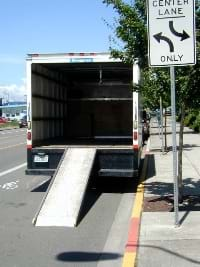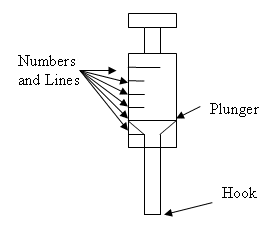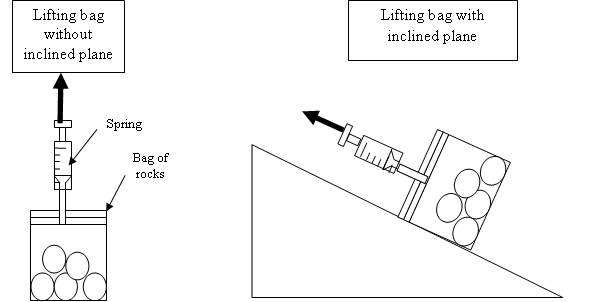Quick Look
Grade Level: 1 (K-2)
Time Required: 30 minutes
Expendable Cost/Group: US $0.00
Group Size: 4
Activity Dependency:
Subject Areas: Measurement, Science and Technology
NGSS Performance Expectations:

| K-2-ETS1-2 |
| K-2-ETS1-3 |
Summary
Students discover the scientific basis for the use of inclined planes. Using a spring scale, a bag of rocks and an inclined plane, student groups explore how dragging objects up a slope is easier than lifting them straight up into the air. Students are also introduced to the scientific method and basic principles of experimentation. To conclude, students imagine and design their own uses for inclined planes.
Engineering Connection
Engineers continually look for and design new tools to make life easier. Students are introduced to this idea by exploring tools that they know and see everyday, in particular the inclined plane. Students act as engineers when they think of and then design tools or machines using incline planes with the purpose to simplify some task in their lives.
Learning Objectives
After this activity, students should be able to:
- Explain that an inclined plane reduces the effective "weight" of an object.
- Explain how to read a spring scale.
Educational Standards
Each TeachEngineering lesson or activity is correlated to one or more K-12 science,
technology, engineering or math (STEM) educational standards.
All 100,000+ K-12 STEM standards covered in TeachEngineering are collected, maintained and packaged by the Achievement Standards Network (ASN),
a project of D2L (www.achievementstandards.org).
In the ASN, standards are hierarchically structured: first by source; e.g., by state; within source by type; e.g., science or mathematics;
within type by subtype, then by grade, etc.
Each TeachEngineering lesson or activity is correlated to one or more K-12 science, technology, engineering or math (STEM) educational standards.
All 100,000+ K-12 STEM standards covered in TeachEngineering are collected, maintained and packaged by the Achievement Standards Network (ASN), a project of D2L (www.achievementstandards.org).
In the ASN, standards are hierarchically structured: first by source; e.g., by state; within source by type; e.g., science or mathematics; within type by subtype, then by grade, etc.
NGSS: Next Generation Science Standards - Science
| NGSS Performance Expectation | ||
|---|---|---|
|
K-2-ETS1-2. Develop a simple sketch, drawing, or physical model to illustrate how the shape of an object helps it function as needed to solve a given problem. (Grades K - 2) Do you agree with this alignment? |
||
| Click to view other curriculum aligned to this Performance Expectation | ||
| This activity focuses on the following Three Dimensional Learning aspects of NGSS: | ||
| Science & Engineering Practices | Disciplinary Core Ideas | Crosscutting Concepts |
| Develop a simple model based on evidence to represent a proposed object or tool. Alignment agreement: | Designs can be conveyed through sketches, drawings, or physical models. These representations are useful in communicating ideas for a problem's solutions to other people. Alignment agreement: | The shape and stability of structures of natural and designed objects are related to their function(s). Alignment agreement: |
| NGSS Performance Expectation | ||
|---|---|---|
|
K-2-ETS1-3. Analyze data from tests of two objects designed to solve the same problem to compare the strengths and weaknesses of how each performs. (Grades K - 2) Do you agree with this alignment? |
||
| Click to view other curriculum aligned to this Performance Expectation | ||
| This activity focuses on the following Three Dimensional Learning aspects of NGSS: | ||
| Science & Engineering Practices | Disciplinary Core Ideas | Crosscutting Concepts |
| Analyze data from tests of an object or tool to determine if it works as intended. Alignment agreement: | Because there is always more than one possible solution to a problem, it is useful to compare and test designs. Alignment agreement: | |
Common Core State Standards - Math
-
Describe measurable attributes of objects, such as length or weight. Describe several measurable attributes of a single object.
(Grade
K)
More Details
Do you agree with this alignment?
-
Directly compare two objects with a measurable attribute in common, to see which object has "more of"/"less of" the attribute, and describe the difference.
(Grade
K)
More Details
Do you agree with this alignment?
-
Represent and solve problems involving addition and subtraction.
(Grade
1)
More Details
Do you agree with this alignment?
International Technology and Engineering Educators Association - Technology
-
Explain the tools and techniques that people use to help them do things.
(Grades
Pre-K -
2)
More Details
Do you agree with this alignment?
-
Safely use tools to complete tasks.
(Grades
Pre-K -
2)
More Details
Do you agree with this alignment?
-
Explore how technologies are developed to meet individual and societal needs and wants.
(Grades
Pre-K -
2)
More Details
Do you agree with this alignment?
-
Analyze how things work.
(Grades
Pre-K -
2)
More Details
Do you agree with this alignment?
-
Asking questions and making observations helps a person to figure out how things work.
(Grades
K -
2)
More Details
Do you agree with this alignment?
State Standards
American Association for the Advancement of Science - Science
-
Tools are used to help make things, and some things cannot be made at all without tools. Different tools have different uses.
(Grades
K -
2)
More Details
Do you agree with this alignment?
North Carolina - Math
-
Directly compare two objects with a measurable attribute in common, to see which object has "more of"/"less of" the attribute, and describe the difference.
(Grade
K)
More Details
Do you agree with this alignment?
-
Describe measurable attributes of objects; and describe several different measurable attributes of a single object.
(Grade
K)
More Details
Do you agree with this alignment?
Materials List
Each group needs:
- 3 worksheets, one each per student
- 1 spring scale, for measuring applied forces
- plastic sandwich-sized bags
- 8-12 rocks, about 2 inches (5 cm) in diameter
- flat piece of wood, ~2 ft long X 1 ft wide X 1 inch thick (60 cm x 30 cm x 2.5 cm)
- stack of textbooks, ~1-1½ feet high (30-45 cm)
Worksheets and Attachments
Visit [www.teachengineering.org/activities/view/duk_heaveho_music_act] to print or download.Introduction/Motivation

Now that we have learned about inclined planes, who can remind us of some real-world examples? (Listen to student ideas.) Examples include roads over hills, skateboard ramps, handicap access ramps, etc. And why do people need and use tools like an inclined plane? That's right - to make work easier. Well today we are going to find out how inclined planes make work easier by acting as scientists and conducting an experiment!
What we're going to do is play the role of an engineer who needs to find the lightest way to lift a bag of rocks. Using an important tool that we will discuss in a minute, we are going to find out how much this bag of rocks weighs and come up with one method to make it "weigh" less. Sound impossible? Let's find out!
Before we begin, let's become familiar with a very important tool that we will be using to do our experiments. This is called a spring scale (show an example). Does anyone know how this works? This tool is used to measure how much something weighs. See this hook ? (The hook is located on the bottom of the device; see Figure 1.) We attach this hook to whatever we want to weigh, like our bag of rocks here. See what happens when something hangs off of the scale? This plunger moves up and down, depending on how much weight is being applied. But how do we know how much the object weighs? If you look closely, you can see lines with numbers next to them on the clear part of the scale. See them? When the plunger inside this clear part is pulled down by the bag of rocks, it moves to one of these lines. See? The number next to that line is the weight of that bag of rocks. Now let's see how we can make it weigh less!
Procedure
Before the Activity
- Gather materials and make copies of the three attached worksheets. The basic activity procedure is outlined through these worksheets.
- Set up at each group's work station an inclined plane, bag of rocks and spring scale. The inclined plane can consist of any hard, flat plane (wooden board, textbook, flat cardboard, etc.) that is propped up on one end between 30 and 45 degrees. While the actual inclination of the flat plane is not important, the steeper the slope, the less pronounced the effect will be.
Pre-Activity with Students
- Use the pre-activity worksheet as a warm-up to get students thinking along the right lines. Explain the basic shape of the inclined plane, consisting typically of a flat board raised on one end. Doing this provides students with a simple template from which they can think of their own examples and applications of inclined planes. If students have trouble, provide a few of your own examples.
- For the next activity on the worksheet, students explore some practical uses of inclined planes by filling in the provided drawing. Note that they can only use straight lines to make a path from a car to the house, meaning that they will have to use more than one line (inclined plane).
Experiment
- Once the pre-activity worksheet activities are completed, divide the class into groups of four students each. Direct students' attention to the experiment worksheet.
- Ask students the provided question and guide their answers correctly.
- Have groups assemble at their work stations (wherever the inclined planes are set up) to begin their experiments. First, attach the bag of rocks to the spring scale and hold it at arm length in the air. Record the number that the scale reads in the second box on the worksheet table, next to their names.
- Once all students in the group have completed this step, have them drag the bag of rocks (attached to the spring scale; see Figure 2) up the inclined plane and record the number on the spring scale in the third box in the worksheet table. Note: Make sure students drag their bags up the plane at as much of a CONSTANT rate as they can. This ensures that they record more accurate numbers, but depending on the age of the students, may not be as important.

Figure 2. The experimental setup.
Post-Experiment Design Activity
- Once all students have completed these steps, gather into one large group to review the conclusion questions on the experiment worksheet. Ask students to calculate the difference in the weight with the inclined plane and the weight without the inclined plane. Make sure students get the idea that using the inclined plane made the bag of rocks feel "lighter" and easier to lift than without it.
- When it is clear that this concept has been conveyed, direct students to the design worksheet for a fun design activity that can be altered to suit the age of the students.
- In the provided space on the worksheet, have students identify a task or activity in their lives (getting to school, doing homework, playing a sport, etc.) that they would like to make easier in some way. Then, tell them to imagine that they are engineers who need to design a machine or tool using an inclined plane to help them with that activity. This is a purely creative and abstract exercise, so their drawings need not to be realistic, but they must incorporate an inclined plane.
- Once their drawings are finished, have them write a sentence or two describing their machines and what they do.
- Conclude by having students share with the class their invention ideas.
Vocabulary/Definitions
angle of inclination: The angle that the inclined surface makes with the horizontal ground. The greater the angle, the greater the effective weight of the object but the shorter the distance to the top of the inclined surface.
effective weight: Weight "perceived" or "felt" by person pulling an object up an inclined plane, defined to be less than the actual weight of the object.
inclined: A slanted surface, a surface deviating from horizontal.
inclined plane: A simple machine without moving parts, used to increase the height of an object. Made using a flat, slanted surface, such as a ramp.
spring scale: A device used to measure the weight of an object in terms of the force it induces when suspended from the scale.
Assessment
Post-Introduction Warm-Up Questions: As a class, go through the warm-up questions on the attached activity worksheet. Guide students' answers and understanding to establish the correct mindframe before beginning the experiment.
Activity Worksheets: Use the experiment worksheet and the concluding design worksheet as tools to evaluate student understanding of the concepts presented.
Activity Scaling
For more advanced students, discuss the advantages and disadvantages of using inclined planes to elevate objects. Also, basic statistical calculations can be made with the data, such as average weights with and without the inclined planes, median and mode. For further investigation, explore the effect of changing the angle of inclination on the two weights of the bag of rocks.
Subscribe
Get the inside scoop on all things TeachEngineering such as new site features, curriculum updates, video releases, and more by signing up for our newsletter!More Curriculum Like This

Students are introduced to the concept of simple tools and how they can make difficult or impossible tasks easier. They begin by investigating the properties of inclined planes and how implementing them can reduce the force necessary to lift objects off the ground.

Students use inclined planes as they recreate the difficult task of raising a monolith of rock to build a pyramid. They compare the push and pull of different-sized blocks up an inclined plane, determine the angle of inclination, and learn the changes that happen when the angle is increased or decre...

Students are introduced to the six types of simple machines — the wedge, wheel and axle, lever, inclined plane, screw, and pulley — in the context of the construction of a pyramid, gaining high-level insights into tools that have been used since ancient times and are still in use today.

Students explore building a pyramid, learning about the simple machine called an inclined plane. They also learn about another simple machine, the screw, and how it is used as a lifting or fastening device.
Copyright
© 2013 by Regents of the University of Colorado; original © 2007 Duke UniversityContributors
Mike McGroddySupporting Program
Engineering K-PhD Program, Pratt School of Engineering, Duke UniversityAcknowledgements
This content was developed by the MUSIC (Math Understanding through Science Integrated with Curriculum) Program in the Pratt School of Engineering at Duke University under National Science Foundation GK-12 grant no. DGE 0338262. However, these contents do not necessarily represent the policies of the NSF, and you should not assume endorsement by the federal government.
Last modified: July 13, 2020










User Comments & Tips